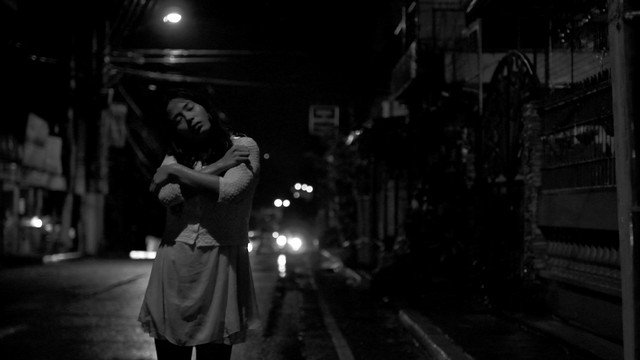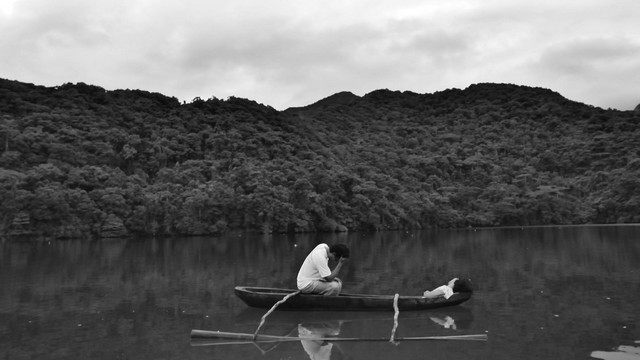Letting Lav Diaz happen to us
 "Florentina Hubaldo, CTE," at the Kino Otok festival in Isola, Slovenia
"Florentina Hubaldo, CTE," at the Kino Otok festival in Isola, Slovenia I suggested to Vanja Kaludjercic that I could perhaps miss an hour of Lav Diaz’s "Florentina Hubaldo: CTE" and she gave me a severe look. “No,” she said. “You should watch the whole film. It’s a very important film.” I felt sheepish; Kaludjercic was the head of programming at the Kino Otok film festival, and she had been the one to bring Diaz’s work to Slovenia this year, after all.
So on June 3, I sat for the whole six hours. I was—on visual guessing—the only person with Filipino ancestry in attendance at the screening. "Florentina" began at 9:30am and continued until 3:30pm. I wanted to have some inborn gene of enthusiasm for six hours in a dark theatre on a nice day. But like many who’ve heard about the length of Lav Diaz’s films, I was intimidated by the viewing.
Kaludjercic wasn’t the only Slovenian film worker who held Diaz in awe. Koen Van Daele, assistant director of programming at Ljubljana’s independent theatre, Kinodvor, instructed me on watching a Diaz film beforehand. “Let the film happen to you,” Van Daele said. He moved his fist in an appreciative, circular motion, simulating a slow ocean wave.
"Florentina" opens with a long, black and white shot of an empty road. I’m in one of the loveliest coastal towns of Slovenia, but the faint sounds relocate me immediately to the motherland. The ubiquitous diesel engines. The rustle of moving palms in the wind. Two figures walk into view in real time: an old man and a young woman. Eventually we see the young woman crouching, her hair falling around her like a protective shroud. We soon see why she needs protection; a man offers her grandfather 3,000 pesos for the goats they bring, and 500 pesos for Florentina. The storylines of "Florentina Hubaldo, CTE" are bleak and oblique. Florentina is sold into prostitution by her monstrous father. Elsewhere, a young woman seems to be dying of tuberculosis while her family can do little but touch her hair and wipe her mouth. And three men dig for supposedly buried treasure, futilely turning up the earth. Throughout the first third of the movie I pen notes, feeling pressured to discern the plot, the meaning, the method of the film. I have no formal background in film language, and this, too, makes me feel sheepish and intimidated. What if I don’t understand it? What if I watch it incorrectly? As a Filipina Italian raised in the States, am I even Filipino enough to have an opinion about this movie? I remember Van Daele’s instruction: Let the film happen to you. I reluctantly put my pen down.
Then I was steeped totally in the scene of a boatman sleeping, his head leaned against his paddle, while his passenger, the tubercular young girl, bleeds from her mouth. We hear the man’s faint snores; we watch the child convulse in what we can only assume are her death throes. The shot—the boat sliding along the surface of a calm lake—is gorgeous. The scene is awful. Which is more horrifying? The woman dying in pain before our eyes? Or the sudden indifference of the sleeping boatman?  Many of the scenes in Florentina are silent; the transitions back to the sound of ripping rainfall, or brutality, made me jump. The scene shifts jarred my consciousness, simulating, I thought, a sliver of the experience of chronic traumatic encephalopathy (CTE), the degenerative disease in victims subjected to multiple head injuries. And what I remember most of the silent scenes is this: Florentina, blurry and barefoot in an urban street, swaying slowly on and off the curb. She reaches both hands above her head, clutching for—what? Mercy? A dance partner? Me? I felt responsible, somehow, implicated in her suffering. At one point, a farmer walks a river, and a voice-over asks the questions repeating in his head. “Where does man’s evil come from? Where does man's violence come from? Why is there sacrifice? Why is there grief? Why is there sorrow? What is the essence of life in this world?” Given the weight and seeming out-of-nowhereness of the questions, this might be a laughable scene to a casual viewer; too elitist-cinema, perhaps, for someone with no film background. But I don’t find the moment elitist. I cannot laugh at it. As I watch, I remember a greater, wiser champion of Lav Diaz: Alexis Tioseco, the 28-year-old film journalist who was killed in his Quezon City home in 2009 with his partner, film writer Nika Bohinc. The circumstances of their unsolved murder, their lives together, and their careers in the art they loved, propelled me to document what I could about their case and their work in film.
Many of the scenes in Florentina are silent; the transitions back to the sound of ripping rainfall, or brutality, made me jump. The scene shifts jarred my consciousness, simulating, I thought, a sliver of the experience of chronic traumatic encephalopathy (CTE), the degenerative disease in victims subjected to multiple head injuries. And what I remember most of the silent scenes is this: Florentina, blurry and barefoot in an urban street, swaying slowly on and off the curb. She reaches both hands above her head, clutching for—what? Mercy? A dance partner? Me? I felt responsible, somehow, implicated in her suffering. At one point, a farmer walks a river, and a voice-over asks the questions repeating in his head. “Where does man’s evil come from? Where does man's violence come from? Why is there sacrifice? Why is there grief? Why is there sorrow? What is the essence of life in this world?” Given the weight and seeming out-of-nowhereness of the questions, this might be a laughable scene to a casual viewer; too elitist-cinema, perhaps, for someone with no film background. But I don’t find the moment elitist. I cannot laugh at it. As I watch, I remember a greater, wiser champion of Lav Diaz: Alexis Tioseco, the 28-year-old film journalist who was killed in his Quezon City home in 2009 with his partner, film writer Nika Bohinc. The circumstances of their unsolved murder, their lives together, and their careers in the art they loved, propelled me to document what I could about their case and their work in film.
I am sitting in Isola, watching "Florentina Hubaldo, CTE," because I traveled to Slovenia for more of Nika’s story in particular. The film magazine she edited, Ekran, dedicated an entire issue to Lav Diaz in 2005; no matter that few Slovenians had ever seen his films. Nika Bohinc was a fan of Lav Diaz before she met Alexis; before the convulsive, Filipino brutality that Diaz portrays in his work took their lives. The Slovenian film workers who explained Diaz to me—Koen Van Daele and Vanja Kaludjercic—cared for, worked alongside, and grieve for Nika. The questions posed by Florentina’s farmer— “Where does man’s violence come from? Why is there grief?”—chill me with their relevance, their circularity.
Throughout the film, Florentina keeps repeating her own name. She tells the story of her birth in Antipolo, her move to Bicol, her mother's death, over and over again, to the goats, to her grandfather, to anyone. She begins to forget, and she repeats herself again. It’s during her fifth repetition that a wave of understanding finally seems to take me. Florentina loses her grasp on the most basic details of her existence. The terrible trauma enacted on her disrupts her sense of self; every brutal invasion of her body tears at her ability to keep any grasp on her identity. In Florentina’s clutching at, and losing, her own self-narrative, we can feel the Philippines’ larger historical suffering. Could it be that the nation itself cannot remember its own name, either? The moniker, after all— Las Islas Filipinas—was determined by a Spaniard, in honor of a Spanish king. With each invasion, the country’s sense of identity endured a tectonic shift accompanied by unspeakable violence. In an oft-colonized country, any original peoples’ narrative may be savagely interrupted, overtaken.
“We deny the truth,” said Diaz in a 2008 interview, “we deny the past. Our suffering was and is very corporal, and it will still be corporal for years to come if we cannot move towards a process of healing, a progressive path.”
To watch a Lav Diaz film, no matter its content, is to be steeped in one uncompromising, holistic vision of the Philippines. It’s a brutal, unsparing vision; it’s difficult to witness. When the film ended in Slovenia, we were left with a final vision of Florentina’s horribly bruised face. An audience member began to clap; no one joined in. We felt exhausted with the depth and importance of what we’d absorbed. Yes, a Diaz film is long; it may feel as long as the history of one very old, very complicated country. But how do you enact change without looking for a long time, unblinkingly, at the beloved, wounded entity you want to change? How can we remember Alexis Tioseco and Nika Bohinc’s names? “Today, in a society so quick to judge and pass blame,” Alexis Tioseco wrote in 2005, “the only flesh that remains to be examined is our own. Diaz’s camera, steadfast, unwavering, reveals the truths only found beneath the surface, and points us on the path to deliverance.” -- HS, GMA News



